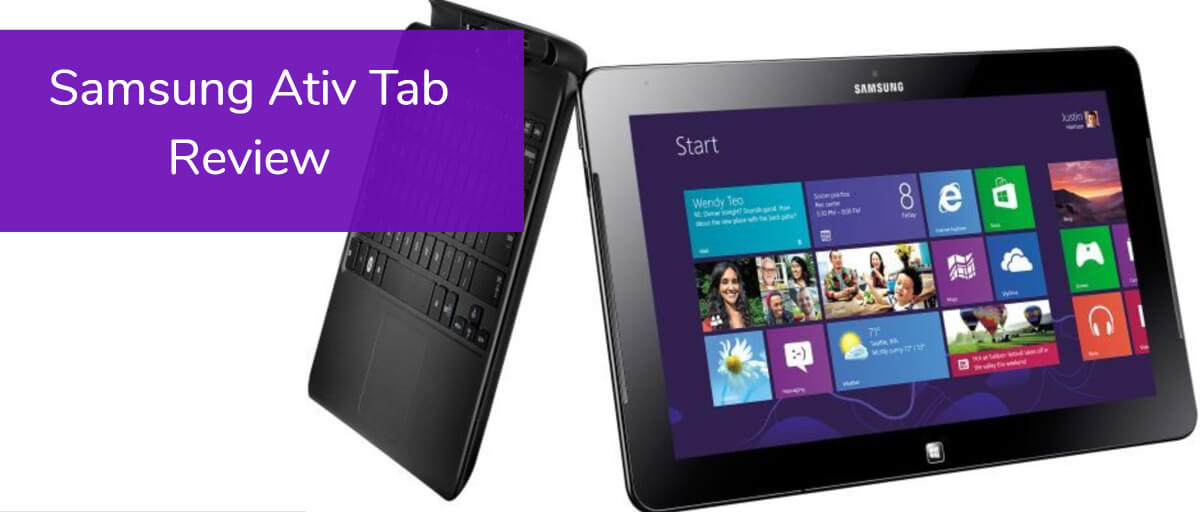Table of Contents
Last Updated on November 5, 2020
For many, the development of Windows RT is puzzling. The inability to run traditional Windows applications appears to be a tremendous omission, and it can be hard to justify choosing RT-powered tablets compared to those running the full-featured Windows 8.
But for certain subsets of users, particularly those who rely on tablets mostly for business or media consumption, Windows RT can be a fine operating system. Those users, then, will be happy to see that Samsung’s ATIV Tab tablet gives the Microsoft Surface RT a run for its money.
Hands-On Impressions
Compared to tablets such as the Surface RT or ASUS Vivo Tab RT, the ATIV Tab feels a bit cheap. This is due primarily to the plastic body, the backside of which is painted to resemble brushed aluminum.
It’s a nice aesthetic touch, but it can’t hide the plastic feel. Although it’s made from plastic, the body does feel quite solid and sturdy. Its 10.4-by-6.61-by-0.27 inch frame comes in slightly smaller than the Surface, and it weighs a quarter of a pound less. It’s a small difference, but it’s noticeable during extended use.
Tablet Tour
In a bit of a strange touch, the top of the ATIV Tab is rather cluttered with buttons and ports. A 3.5-millimeter jack, power button, volume rocker and microSD card slot are all crammed up top, along with micro-HDMI and USB 2.0 slots.
The only other items to be found anywhere on the device’s edges are on the bottom, where a power plug and docking port are joined by the slots in which the keyboard dock can be secured. It’s a rather unconventional button placement scheme, and it will surely take some getting used to.
At bottom front is the standard Windows home button, along with a 1.9-megapixel camera.
Resolving the Details
As with all other Windows RT devices, the Samsung Tab sports a somewhat mediocre 1,366-by-768 display. Given the 10.1-inch size, this works out to 155 pixels per inch.
A comparison of tablet displays gives the ATIV Tab an edge in this regard, outpacing the 148 ppi of the Surface RT and the 135 ppi of the ASUS Vivo Tab RT. Brightness is slightly better than the Surface, but it can’t compete with the 600-nit brightness of the Vivo Tab.
Viewing angles are excellent, however, and overall picture quality is very good for a standard Windows RT panel.
Under the Hood
Beneath the faux-aluminum exterior of the ATIV Tab lies a Qualcomm Snapdragon S4 dual-core processor running at a brisk 1.51 gigahertz, along with two gigabytes of RAM and 32 or 64 gigabytes of storage.
This hardware package is the same one that powers Dell’s XPS 10, and it delivers similarly solid results. Compared to tablets which feature quad-core processors this hardware may not be particularly impressive, but it does deliver well enough under most circumstances.
Booting and loading apps takes some time, but that’s more a problem with Windows RT than with the tablet itself. Its battery life, meanwhile, is simply exceptional. The tablet alone manages the sort of longevity that is normally only seen in tablets which utilize a secondary battery inside a keyboard dock.
Tablet Roundup
Ultimately, given the similar hardware and specifications of most Windows RT tablets, comparisons come down to the small details. In this case, the fantastic battery life and lightweight, portable design of the Samsung ATIV Tab makes it an appealing choice over competitors such as the ASUS Vivo Tab RT or Dell XPS 10.
Its display is quite solid, though the Surface RT may get the nod thanks to more vivid color and contrast. Perhaps the biggest consideration, however, is price. The ATIV Tab is certainly a very solid Windows RT tablet, but it comes at a cost that may be difficult to justify given the small differences between it and its competitors.

